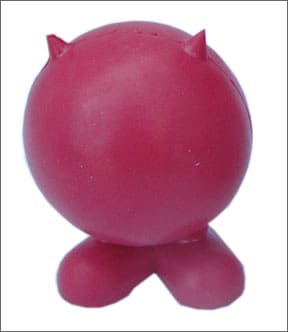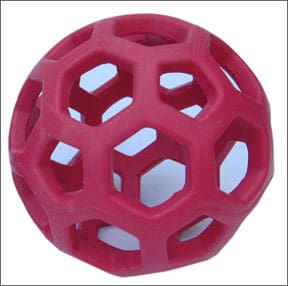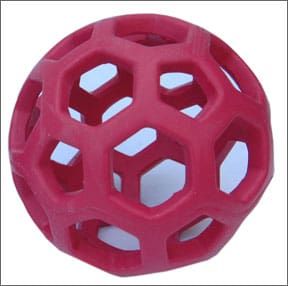[Updated August 2, 2017]
VINYL EXPOSURE TO DOGS OVERVIEW
– Don’t buy vinyl toys for your dog, especially if you have a puppy or a breeding adult dog.
– Notice where you’ve got vinyl in your house, car, and elsewhere in your life so you can eliminate as much of it as you can, to reduce your dogs’, your kids’, and your own exposure to it.
– Vacuum your home and car regularly to remove some of the phthalate-laden dust.
– Organize or support efforts to establish laws that protect both children and pets from exposure to problematic phthalates.
A few years ago, I bought a special bed to help Caleb, my Bouvier des Flandres, live more comfortably with his arthritis. When filled with water, it was supposed to provide him with a cool and supportive cushion. It sounded great.
I looked forward to giving the bed to Caleb. But the moment I took it out of the box, it gave off a powerful odor. Even the cardboard box smelled of it. The odor was so intense that I had to back away from it.
Within minutes, the sharp, distinctive smell penetrated my entire house. I wondered whether the bed might be outgassing industrial chemicals, although I didn’t know at the time exactly what kind they might be. What I did know was that my sensitive nose couldn’t stand the smell – and if I couldn’t stand to inhale around the bed, I certainly wasn’t going to let Caleb snooze on it! So I whisked the bed outside to the front porch, hoping that passing breezes and ultraviolet rays from the sun would diffuse the source of the odor so that I could bring it back inside and give it to my guy. But it smelled as bad a week later as it had on Day One. Following my intuition that such a thing was not good for us, I took it back for a refund.
Turns out, it’s a good thing I trusted my instincts. The bed was made of vinyl – and the substances in vinyl that smell so awful are suspected of causing all sorts of health problems in animals and humans alike.
If Vinyl Isn’t Safe for Kids . . .
Over the past few years, public concern has increased about the safety of vinyl products, particularly in items made for kids. This concern has focused on the presence of certain additives used almost exclusively in vinyl. In response, nine major governments from around the world and many more municipalities have now banned or advised against the use of these additives in children’s toys, and sometimes also in childcare items. The state of California (2007), the European Union (EU, 2005), Japan (2003), Fiji (2000), Argentina (1999), and Mexico (1998) have passed laws enforcing such restrictions, and the Philippines recently introduced legislation in its Senate. Canada (1998) and Australia (1998) have asked for voluntary measures or issued health advisories about additives in vinyl, and Australia has just conducted a new investigation into the matter.

These governments have acted because they are convinced of the risk that additives will transfer out of vinyl products and release enough toxins to damage a child’s physical development. They believe this because recent studies have shown that the plasticizers used to soften vinyl interfere with the development of the very young and can do other damage, as well. The conclusions of these studies have been drawn from testing on animals. But even though tests based on animals have spawned legislation to protect human babies and children, it appears that animals themselves benefit from little, if any, similar protection. This discrepancy has grabbed my attention. It should also grab yours.
What is Vinyl?
“Vinyl” is the common name for polyvinyl chloride, or PVC. It’s a cheap plastic that’s used to make all kinds of stuff. In fact, it’s just about everywhere. You and your dog almost certainly have vinyl in your lives.
Chlorine constitutes one of vinyl’s primary chemical building blocks. It’s well known that under certain conditions chlorine produces some of the most dangerous pollutants humans have yet created: dioxins. Dioxins cause cancers, reproductive and developmental problems, and immune system damage in animals; they also spread around the environment and concentrate further as they work their way up the food chain.
Dioxins are by-products of several significant industrial processes, one being the manufacture of vinyl. And vinyl produces dioxins not only when it’s made, but also if it ends up being incinerated in a deliberate or accidental fire at the end of its useful life. Plus, vinyl is very dicey to recycle, since the chlorine it contains cannot be mixed with other plastics. The development of vinyl brought some deadly problems into the world.
Between manufacture and disposal, vinyl itself is pretty stable; toxicologists tend to agree that it’s probably safe for the user. But PVC, by itself, is too hard and brittle to do much with, so manufacturers infuse it with a number of additives that make it soft, flexible, and willing to take colorants. They may also add fragrances. According to Dr. David Santillo, senior scientist with the Greenpeace Research Laboratories based at the University of Exeter in the UK, “You can end up with a vinyl product of which only a small proportion is actually the polyvinyl chloride plastic.” And there’s the rub. While vinyl itself may be relatively safe during use, its additives are not.
Why is Vinyl Toxic?
Vinyl may contain a number of additives known to be highly toxic, among them lead, organotin, alkyl-phenols, and bisphenol-A, to name but a few. But those getting the most attention today are called “phthalates.” Phthalates (correctly pronounced with an “f” sound immediately before the hard “th” sound) is the common name for phthalate esters. These human-made chemicals, when introduced into vinyl, make it soft and cooperative. They do this very well in part because their molecules do not bond to PVC, but rather move freely through it. And because they move through it, they also move freely out of it and into the surrounding environment.
The phthalates used to plasticize PVC are what give it that familiar “vinyl” smell. If you can smell vinyl, then you – and your dog – are inhaling phthalates that are out-gassing. Over a product’s lifetime, vinyl phthalates will leach out completely into any skin, other living tissue, air, water, and earth with which it comes into contact. That’s why old vinyl becomes so dry and brittle. A good general guideline is, the stronger a vinyl product smells, the greater the amount of phthalates it contains. (Am I ever glad I returned that malodorous cooling bed that I bought for Caleb, in spite of its potential to be an otherwise great product.)
Of the many different kinds of phthalates, not all have been equally studied. Not all are used in vinyl. Not all may be equally dangerous, and some may not even be dangerous. But six types that are normally found in vinyl have been identified as culprits behind some serious health concerns. They are:
-
DINP (di-isononyl phthalate)
-
DEHP (diethylhexyl phthalate)
-
DNOP (di-n-octyl phthalate)
-
DIDP (di-iso-decyl phthalate)
-
BBP (benzyl butyl phthalate)
-
DBP (dibutyl phthalate)
All six of these chemicals have been banned in the European Union for use in children’s toys and childcare products, and it’s to them that I normally refer when I mention “phthalates” in this article.
How Phthalates Interfere with Health
Phthalates can compromise the integrity of the body in a variety of ways. For example, they can cause measurable toxicity and biochemical changes in the kidneys and liver. However, the negative effect that garners the most press is reproductive problems. This may include lowered sperm count, abnormal sperm, and, at a more profound level, improper development of sex organs, especially in males, according to Dr. Santillo.

Further observations show correlations between phthalate exposure and undescended testicles in young children, inappropriate levels of certain hormones in the bodies of newborn babies, and a shortening of the distance between the anus and the genitalia. Such correlations in themselves, he adds, are not proof of cause and effect, but they ring the same alarm bells as those studies that do show cause and effect.
Phthalates initiate reproductive damage at what Dr. Santillo describes as “a very fundamental, cellular level.” They do this by interfering with the chemical communication between cells during certain critical stages of development. Babies in the womb can be affected if their mothers are exposed to phthalates. Newborns and very young children are also vulnerable and may be exposed through many sources, including breast milk.
Although phthalates pose other possible risks besides the ones mentioned above, their known effects illustrate that they can cause severe problems to health. I believe that we need to take these things into account as we choose which kinds of substances we choose to interact with – or select for our dogs. In fact, because of the ways they naturally interact with the physical world, our dogs may be at particular risk of absorbing phthalates.
Speeding Phthalates’ Release
Both puppies and human babies love to mouth things, especially when they’re teething. But, whereas babies eventually outgrow this tendency, most dogs keep joyfully chewing for the rest of their lives, putting them at an increased risk.
The problem arises because phthalates transfer easily from PVC into the surrounding environment. Although they don’t need specific conditions to cause this and will leach out of a vinyl object that’s sitting quietly all by itself, certain factors will speed up the process. The most effective one of all is what Dr. Santillo calls “mechanical pressure,” which means when something squeezes the object.
The following canine contributions put dogs at special risk of absorbing phthalates from vinyl:
-
Chewing (an outstanding example of repeated mechanical pressure)
-
Saliva (liquid)
-
Body heat (increased temperature)
-
Digestion (when pieces of vinyl get swallowed)
-
Inhalation of airborne chemicals
-
Skin contact (snoozing on or leaning against something)
All of these are a factor when a dog chews a vinyl toy. But some, such as warmth, inhalation, and skin contact are part of other scenarios too, such as when a dog sleeps on a vinyl bed. Taking these factors into account, the EU has banned the six major phthalates not only from kids’ toys, but also from many other products used by children. Governments are enacting protective legislation for humans; protections for animals are needed. “I see no reason why the same measure should not be immediately justifiable in order to protect those other members of our families, namely, our pets,” says Dr. Santillo.

As long as dogs (and other animals and kids on this continent) don’t have similar protective legislation, they depend upon us to decide what they’ll be exposed to. By learning more about how phthalates (not to mention other industrial chemicals) can affect our dogs, we can make better choices about what we buy for them.
Other Additives in Vinyl
Although phthalates may be the most worrisome additives found in vinyl today, others also pose serious health threats. When combined, they can be even worse. “When you’re using vinyl, you’re inevitably exposed to a very complex mix of chemicals,” explains Dr. Santillo. “Whereas predicting the effects of exposure to a single chemical is complicated to start with, looking at the effects of exposure to mixtures can be even more complicated.” The possible presence of these and other synthetic chemicals multiply the reasons to avoid vinyl.
Here’s some dope on a few vinyl additives:
Lead: Used as a softener. Damages the nervous system in humans and animals, causing cognitive and behavioral problems. No known “safe” level of exposure. This is more of an
issue in older vinyl than in newer stuff, but lead has shown up recently in imported painted pet and children’s toys. (To be sure to avoid it, don’t buy painted toys for your dog unless you’re certain they’re lead-free.)
Organotins. Mono- and di-butyltins used extensively as stabilizers, for example, in vinyl flooring. Di-butyltin is toxic to the immune system in mammals. Some of this family of
synthetic chemicals can disrupt the sexual development of marine animals. Not all organotins are used in PVC, but given the high toxicity of some chemicals in this category, scientists such as Dr. Santillo regard those used in vinyl as a concern.
Alkyl-phenols (nonyl and octyl). Used in the preparation of phthalates or in the extrusion process in drawing out flexible PVC. Well known for their ability to mimic estrogen hormones.
Bisphenol-A. Used as a stabilizing antioxidant in certain phthalate preparations; it stops phthalates from breaking down. A strongly estrogenic endocrine disruptor. Can add to “cocktail effects” by mixing with other vinyl additives. Linked to some forms of cancer.
The Danish Vinyl Study
Scientists believe phthalates to be dangerous for humans due to results of tests they’ve carried out primarily on rats and mice. However, they’ve seen similar outcomes in experiments on primates as well as in some observations of humans. These problems show up across a wide range of mammals. Although phthalates may have been tested on comparatively few canids, Danish researchers have recently spoken up on behalf of pet dogs (and cats), stating that they can suffer the same ill effects from these chemicals as can rodents, primates, and humans.
In 2006, the Danish Ministry of the Environment (MoE) published a report entitled (in the English translation) “Evaluation of the health risk to animals playing with phthalate-containing toys.” The researchers started with the results of a 2005 investigation into vinyl toys that had been marketed for dogs and cats in Denmark. The 2005 study had found that anywhere from 10 percent to 54 percent of the total content of tested toys consisted of DEHP or DINP. Both of these phthalates ranked among the six that the EU had already banned from toys and products that were marketed for human children. Based on these as well as other findings, the 2006 MoE project looked at the rate of phthalate transfer into, and its potential effects on, dogs and cats who played with toys that contained the chemicals.
The authors of the 2006 report also reviewed data from other studies. For example, when they compared data from tests carried out on rats with results of the few tests carried out on dogs, they found that DEHP and DINP cause similar reproductive and liver damage in both species.
From this they reasoned that findings about the dangers of phthalates, drawn from studies carried out on rats, should be seen as significant not only for humans but also for dogs and cats. They also took into account behavioral differences between dogs and cats and the different uses of various kinds of products.
For example, they noted that veterinarians have discovered that when swallowed, soft plastic toys often become hard and sharp during the short time they spend in the gastrointestinal tract. This indicates that the leaching-out of softeners accelerates while the plastic is inside the dog.
In the end, they resolved that the greatest danger lay with dogs playing with toys containing phthalates, since repeated mechanical pressure (chewing) and the presence of saliva speed up the phthalates’ release. (They were less concerned about cats’ oral exposure since cats tend to play more with their paws than with their mouths.)
The 2006 study presented five conclusions, which I summarize here:
1. Dogs who eat even small amounts of PVC toy per day can be exposed to toxic doses of DEHP, which can cause reproductive damage.
2. Phthalates migrate into dogs’ saliva at rates that can increase the toxic effects of the chemicals.
3. The exposure of pregnant or nursing bitches (for even a very short time) during their puppies’ critical development periods to toys containing DEHP can put the puppies’ reproductive health at risk.
4. Dogs who eat even small amounts of PVC toy per day may also be exposed to toxic doses of DINP, which can cause liver damage with sufficient ongoing exposure.
5. Toys may be a major source of phthalate exposre to dogs. Allowing that other sources (for example the environment, food and consumer products) also expose dogs to a variety of phthalates, combined and more significantly destructive phthalate actions could be expected.
The Danish study recommends that owners “reduce the potential health risk to their animals by limiting the animal’s use of toys that potentially contain phthalates especially during pregnancy and (when they are) pups.”
In other words, don’t give your dog vinyl toys to chew on, especially when pups are involved.
But while PVC toys may be the worst source of dogs’ exposure to phthalates, they’re not the only one.
How to Tell if It’s Vinyl
– Be like a dog and sniff all sot plastic pet and household products. If it smells like “vinyl,” it probably is.
– Check labels and packaging for content descriptions that say “vinyl” or “PVC.”
– Check the product (not its packaging) for a recycling symbol with #3 PVC (or #3 V). Products with no recycling information may still be vinyl.
– If a soft plastic product does not have that characteristic vinyl smell and lacks a recycling symbol or labelling, ask the retailer for more information. lf the retailer can’t tell you what the product is made of, ask the manufacturer. lf no one can or will tell you, look for a more clearly labelled alternative.
Other Vinyl Exposure Sources
Besides in chew toys, vinyl can show up in dogs’ collars, leashes, clothing, bedding, carriers, and dog tents (it can be in the mesh or used as waterproof undercoating) – in short, in just about anything. It also shows up in the human-made environment you share with your dog. Here are a just few examples to think about.
Vinyl linoleum flooring. Phthalates measure at much higher levels of intensity close to the floor, where pets and kids spend their time. They measure at reduced levels higher up, where most adult humans spend their time!
House dust. House dust has been found to contain substantial amounts of phthalates. Scientists now believe that it’s a very significant source of exposure to pets, who wash themselves by licking and taking internally what they clean off their fur.
Car dashboards. That “new car smell” comes at least partly from phthalates leaking from the dash or any other interior vinyl to penetrate the air inside the car. If your dog loves to ride along, think about how much time she spends in the car waiting for you, and what you might do to improve the situation.
Clothing, bedding, strollers, and camping equipment made for humans.Take, for example, the $800 I spent a few years ago on a respected name brand “technical” nylon tent with room for two adults plus Bouvier, so that we could spend summer nights together in national parks breathing in the fresh air and delectable scents of the wilderness. However, even after several years, the PVC undercoating used to waterproof the tent outgases a strong odor of phthalates and completely dominates our tent’s “indoor” air. Needless to say, this does not make us happy campers.
Vinyl in Your Dog’s Life and Safer Alternatives
After reading this article, it may surprise you to learn that products made with vinyl and intended for dog play or dog care are readily available in every pet supply store and catalog. Some are made and sold by high-profile, reputable companies. Whether the makers of these products don’t know, don‘t care to know, or don’t believe the studies about the dangers of vinyl and vinyl additives, it’s impossible to say.
In addition to the wealth of products openly labelled as “vinyl,” we found a number of products labelled with text that seems to acknowledge that someone, somewhere in the
products’ manufacturing company, is aware that there may be problems with vinyl. We found toys and other products whose labels said “nontoxic vinyl.”
Don’t be fooled: the “nontoxic vinyl” statement reflects the politics of labelling, not the safety of vinyl products. The vinyl industry lobbies to keep consumers believing that vinyl is safe in spite of mounting evidence to the contrary. Vinyl releases toxins during manufacture and disposal, and it’s usually softened with phthalates, which are toxic. Therefore, based on information available today, vinyl cannot be non-toxic. (Dr. Santillo warns that phthalate alternatives may not be safe, either, and they haven’t yet been adequately researched.)
Some vinyl products are labelled “phthalate-free.” However, the U.S. Public Interest Research Group has found, in random testing, that many toys labelled “phthalate-free” do
in fact contain phthalates. Its report, “Trouble in Toyland: 21st Annual Toy Safety Survey,” (2006) states, “Nothing in the law has changed to hold toy makers accountable to the
‘phthalate-free’ label.”
The safest alternative is simply to avoid vinyl.
Toys
In our opinion, the use of vinyl in dog toys is more dangerous than other applications. This is due to the number of mechanisms that come into play when a dog chews a toy that can contribute to the release of toxic substances from the vinyl into the dog (chewing, saliva, warmth, digestion, skin contact).
We contacted a few makers of vinyl toys to discuss their use or vinyl. Some would not respond; we appreciate those who did, such as Hyper Ploducts, of Wayzata, Minnesota, which sells a line of vinyl dog chew toys called Hardware Hound. These include a toy wrench, hammer, round file, and chisel, all of which give off a strong “vinyl” odor. The packaging says the products are made of “nontoxic vinyl.”
Ward Myers, president of Hyper Products, responded to our inquiry with the following:
“Our currrent product line does not have PVC or phthalates in them. They are made from
vinyl. We also test all of our products for lead and all products are safe.” When we pointed out that vinyl is PVC and almost certainly contains phthalates, Myers emailed us a document called “Why Vinyl is a Leading Material for the Toy Industry,” which praised the safety of vinyl and phthalates in children’s toys based on data drawn “as recently as 1997.” However, the shift toward evidence that phthalates are not safe has taken place since that date.
When we asked another pet products company, Hueter Toledo, Inc., of Bellevue, Ohio, about its vinyl dog toys (including one of our former favorites, the “Soft-Flex Clutch Ball”), Carey Stiles, company president, confirmed right away that some of its chew toys were vinyl, and acknowledged that phthalates are controversial. She also pointed out that they make another popular toy that is not vinyl; the “Best Ball.” That’s the one we’d buy for our dogs to play with!
Beds
Beds that are meant to be filled with water, such as the Cool Bed lIl, made by K & H Manufacturing and widely sold in pet supply stores and catalogs, are commonly made of vinyl. A profoundly better choice would be a completely nontoxic bed, such as the Boulder Zen Dog Bed made by DoggyArchy of Vail, Colorado. Owner Virginia Briggs of DoggyArchy told us that this bed is made in the U.S. of pesticide-free hemp and flax, and filled with kapok fibers. Awesome!
Raincoats
Raincoats for dogs are frequently made of vinyl, and often are clearly labelled as such, like the Puddles Dog Raincoat made by Fashion Pet, lnc. (Ethical Products). But you have
to do some detective work to find the vinyl in other products, such as the Outward Hound Designer Rain Jacket, sold by The Kyjen Company. On its website. Kyjen describes this coat as an “alternative to the traditional vinyl rain slickers that have been on the market for years.” However, when we asked the company what made the coat waterproof, a representative responded, “The material is nylon with PVC backing.”
A better choice would be the Rain Slicker by Chilly Dogs. Company owner/product designer Julie Kelly said the nylon outer shell fabric is coated with polyurethane – no vinyl or phthalates. Another good alternative is the Waxed Cotton Dog Jacket by Barbour. The coat is made of 100 percent cotton, coated with wax, and contains no PVC. It’s made in England but sold by Orvis in the U.S.
More Safe Alternatives to Vinyl Products
The best way to avoid toxins from synthetic chemicals is to not buy synthetic products. But they’re hard to dodge these days, and even natural things my be treated with nasty stuff. Besides, you may feel that synthetics offer certain advantages. You don’t need to change everything at once, but as you are able to afford to and as you need to replace things, these tips can help keep your dog – and you – safer.
– When shopping for your dog, look for products made from materials that are natural or nearly so, such as toys made of felted wool or natural rubber, real bones to chew, organic cotton or hemp beds, and glass water bowls. Try to avoid synthetic additives such as fragrance or color.
– Replace vinyl-containing athletic shoes with shoes made of canvas or real leather. This is especially important in a household with dogs who chew shoes!
– Consider buying a waxed canvas raincoat for your dog. They are more difficult to find than vinyl coats, but are worth the effort. If you prefer a synthetic coat, choose one without vinyl. Although there are concerns about polyurethane and other chemicals that are used to make high-tech fabrics water-resistant, PVC is arguably worse.
– Nylon mesh is less toxic than PVC mesh used on dog tents, carriers, and crate or stroller covers. Watch out for PVC under-coating on these items as well.
– When you must replace a vinyl floor, choose natural, non-vinyl linoleum from “greener” flooring suppliers instead.
– Don’t berate yourself if you’ve bought vinyl products for your dog in the past. PVC has become part of our culture, and it will take time to change that.
If You Already Have Vinyl Products…
– Replace vinyl chew toys with non-vinyl toys. Don’t give the vinyl toys away, either; get them recycled if you can. DON’T bury them under any circumstances!
– Never let your dog chew on shoes that contain vinyl imitation leather (lots of gym shoes do these days).
– Replace vinyl dog boots with ones made from alternatives such as non-PVC-coated nylon with natural rubber soles.
– Reduce or improve your dog’s car time. Cover vinyl seats or the “shelf” under the back windshield (where small dogs like to perch), and wash covers often. Open windows enough to encourage air exchange. Find an outward—blowing fan for car windows. Don’t leave your car exposed to sunlight even on a mild day, since phthalates release faster in warmth.
– lf your dog carrier, stroller, or tent has a PVC mesh screen, replace the mesh with a nylon screen. Meantime, roll up the vinyl mesh if you can so your dog doesn’t have to breathe through it (or have its sharp odor interfere so much with more dog-important smells!)
– Store vinyl raincoats (your own and your dog’s), carriers, tennis shoes, etc., outside your home, if possible. Or at least be thoughtful about where you keep them.
– Vacuum your home and car regularly. If you can’t get to them often as you’d like, even doing one area at a time will improve things by removing some of the phthalate-laden dust.
– lf you’ve got vinyl floors, open your windows; use fans and air exchangers to move low air out. Don’t feed or give your dog treats directly on a vinyl floor. Encourage him to sleep on other floors; if he won’t, put down rugs and wash them often.
– Replace vinyl shower curtains and window blinds with non-vinyl ones when you can.
– Don’t use your dog’s vinyl raincoat if she doesn’t really mind getting wet. Replace it with a non-vinyl coat as soon as you can.
– Don’t sweat it too much! Vinyl is almost everywhere. Any reduction of its use in your home will help.
Don’t Panic, But Do Act
While we can’t expect, in the immediate future, to totally eliminate vinyl from our dogs’ lives, we can expose them to less of it by making thoughtful choices on their behalf.
Protecting the ones we love from the many kinds of human-created, disruptive chemicals that permeate the earth today can seem like an overwhelming challenge. But if you want a good place to start, choose vinyl as the number one plastic to avoid. Why? Because vinyl contributes such a large brew of toxins throughout its manufacture, use, and disposal. And because every person who cuts back on its use can make a real difference for their dogs, themselves, and the planet.
Susan Weinstein is a freelancer who writes about dogs, healthcare and humane issues. She also collaborates with long-time holis-tic practitioner Paul McCutcheon, DVM, on the subject of pet care and stress. Weinstein lives in Grafton, Ontario.







My dog like to shoe all plastic toys…